Compact Range Chambers
Most antenna measurements need to be carried out in the far field; that is, the test antenna should be illuminated by a plane wave. Typically this is carried out by providing sufficient separation between the source and the AUT so the spherical wave approaches a plane-wave character.
Compact range chambers are an excellent alternative to traditional far-field ranges; testing that can be accomplished on a far-field range can be accomplished on a compact antenna test range. This method of testing allows an operator to employ an indoor anechoic test chamber at a reasonable cost and avoid the problems associated with weather and security concerns often encountered when using an outdoor test range.
Compact Range Methodology
This short range test method, (Compact Range) was invented by Richard C. Johnson in the late 1960’s. Basically the equipment under test is placed in the radiating near zone of a large reflector; it was determined that if the reflector was large enough and the edges were manufactured in a way that they were properly terminated in the field in the radiating near field, (the area between the near-field and far-field of the antenna aperture) would be uniform enough in both amplitude and phase for electromagnetic testing. The energy off the reflector is lined up into a much focused beam with uniform phase distribution on the axis of the reflector. So this method gives you the approximation of the far field by the use of a parabolic reflector.
In principle, the operation of a compact range is straightforward; however, its ultimate design, construction, and installation should be carefully considered.
Compact Range Chamber Design
A Compact Range chambers footprint depends on several factors, the testing to be performed, (antenna patterns–RCS measurements), the size of the equipment under test and the lowest frequency range to be tested. Oftentimes shielding effectiveness is not a primary concern and stick-built construction providing ~75dB of shielding effectiveness is adequate. However, if additional SE is required modular panel and welded systems are available.
Cuming Microwave’s C-RAM SFC broadband RF absorbers are specially designed to provide premium performance in anechoic chambers at both normal and off normal incidence angles and can safely withstand continuous field intensity of up to 400 V/m and intermittent field intensity of up to 750 V/m.
Turnkey Systems
Cuming-Lehman Chambers, with the collective experience of our teaming partners feel confident that we can provide an overall fully compliant technical package that offers you a lowest risk, budget friendly solution while meeting all your testing requirements. All of our products are designed to work together for maximum efficiency and performance.
For additional information or a quote contact us today.
[tab:Chamber Construction / Installation]Chamber Construction / Shielding Options
- Stick Built– This is a term we us to describe typical construction methods (metal studs, plywood on the inside and painted drywall on the exterior). We line the interior with 26ga galvanized sheet steel and tape the seams. Done correctly you can easily get 75dB of shielding effectiveness.
- Modular– This is a method utilizing a hat and flat clamping system designed to hold ¾” thick, solid, (structural) core panels laminated with 26 gauge, electrolytically deposited zinc sheet steel. This system is designed to provide better than 100db of shielding effectiveness, effortlessly meeting MIL-STD 285 and IEEE-299. An advantage of this system is the chamber can be relocated because it’s totally self-supporting.
- Welded– Welded Anechoic Chambers employ high quality peripheral steel with continuously welded seams and joints. Typically used when security is an important issue; however, once constructed relocating the chamber in nearly impossible. High performance doors and special waveguide vents are incorporated into the system to attain >120dB of shielding effectiveness.
Absorber Materials
- Broadband Foam Absorber
- Mounting Methods
- Velcro Attachment
- Spray Adhesive
- Clip and Rail (Mechanical Attachment)
Compact Range Chamber Accessories
- Lighting
- Filters
- CCTV and Intercom Systems
- Doors and Ramps
- HVAC Systems
- Fire Detection/Suppression Systems
- Test Equipment


